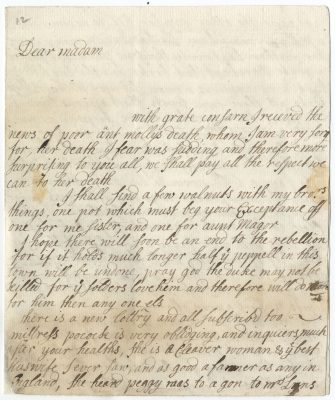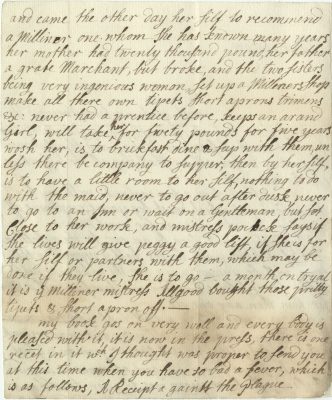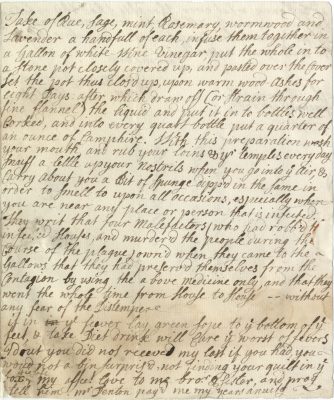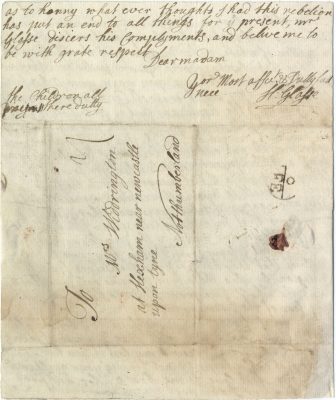Letter from Hannah Glasse to Mrs. Widdrington, circa 1746
Reference: ZAL 40/3
Suggested age groups: KS2, KS3, KS4, Lifelong Learners
Subject areas: 18th Century Food and Cookery, Letter Writing, Alternative remedies
CONTEXT
Hannah Glasse (1708-1770), the daughter of Isaac Allgood a Northumbrian landowner, was a cookbook author. In 1747 she published the cookery book ‘The Art of Cookery made Plain and Easy’.
Before there were telephones, telegrams or computers, people stayed in touch by writing letters to each other. In the 18th century, letters were handwritten, and the writer would include news about their lives and what was happening.
In 1746 Hannah Glasse was living in London and wrote to her Aunt, Margaret Widdrington who lived near Hexham. Margaret was her father’s sister. A number of the letters Hannah wrote to Margaret have survived and they tell us about Hannah’s life and also about events taking place at the time – her cookery book was at the printers; the 1745 Jacobite Rebellion and her own recipe for warding off the “Plague”.
Letters in the 18th century were postmarked but did not have stamps. Postage was also paid by the person receiving the letter and not the sender. The Mail coach was not introduced until 1782. Prior to that, letters would have been taken around the country by either mounted local post boys or stagecoach travelling between towns. The letters were delivered to the local postmaster who would arrange for their delivery by hand. This process could take several days as horse drawn coaches could only travel at between 5 and 8 miles per hour depending on the roads and the weather conditions.
Hannah’s letters are written in a “chatty” style and indicate that she had received education. Her spelling and lack of punctuation seems odd to the modern reader but at this stage all spelling was phonetical and not standardised and so they are typical of their time.
The following is a translation of the letter.
To
Mrs Widdrington at Hexham, near Newcastle upon Tyne, Northumberland
Dear Madam
With great concern, I received the news of poor Aunt Molly’s death, whom I am very sorry for. Her death, I fear, was sudden and therefore more surprising to you all. We shall pay all the respect we can to her death.
I shall find a few walnuts with my brother’s things, one pot which must beg your acceptance of, one for my sister, and one for Aunt Maggie.
I hope there will soon be an end to the rebellion for if it holds much longer half the people in this town will be undone. Pray God the Duke may not be killed for the soldiers love him and therefore will do more for him than anyone else.
Mistress Pocock is very obliging, and enquires much after your healths. She is a clever woman and the best housewife I ever saw. And as good a farmer as any in England. She heard Peggy was to go to Mrs Lynn’s and came the other day herself to recommend a milliner, one whom she has known many years. Her mother had twenty thousand pounds, her father a great merchant, but broke. And the two sisters, being very ingenious women, set up a milliner’s shop, make all their own tippets, short aprons, trimmings etc. Never had an apprentice before. Keeps an errand girl. Will take her for £50 pounds for five years. (She) is to breakfast, dine and sup with them, unless there be company to supper, then by herself. (She) is to have a little room to herself, nothing to do with the maid, never to go out after dusk, never to go to an inn or wait on a gentleman, but set close to her work. And Mistress Pocock says, if she lives, she will give Peggy a good lift, if she is for herself or partners with them, which may be done if they live. She is to go a month on trial. It is the milliner Mistress Allgood bought those pretty tippets and short apron off.
My book goes on very well and everybody is pleased with it. It is now in the press. There is one recipe in it which I thought was proper to send you at this time when you have so bad a fever, which is as follows:
A Recipe against the Plague
Take of rue, sage, mint, rosemary, wormwood and lavender a handful of each.
Infuse them together in a gallon of white wine vinegar. Put the whole into a stone pot closely covered up and pasted over the cover.
Set the pot, thus closed up, upon warm wood ashes for eight days, after which draw off (or strain through fine flannel) the liquid and put it into bottles well corked.
And into every quart bottle put a quarter of an ounce of camphor.
With this preparation wash your mouth and rub your loins and your temples every day.
Snuff a little up your nostrils when you go into the air and carry about you a bit of sponge dipped in the same in order to smell to upon all occasions, especially when you are near any place or person that is infected.
They write that four malefactors (who had robbed infected houses, and murdered the people during the course of the plague) owned, when they came to the gallows, that they had preserved themselves from the contagion by using the above medicine only, and that they went the whole time from house to house – without any fear of the distemper.
I doubt you did not receive my last. If you had you would not have been surprised not finding your quilt in the box. It is safe.
My affectionate love to my brother and sister, and pray tell him Mr Denton paid me my year’s annuity.
As to Henny, whatever thoughts I had this rebellion has put an end to all things for the present.
Mr Glasse discerns his compliments, and believe me to be with great respect, dear madam, your most affectionate and dutiful niece.
H Glasse
ACTIVITIES
ACTIVITY 1
Background
Before there were telephones, telegrams or computers, people stayed in touch by writing letters to each other. In the 18th century, letters were handwritten, and the writer would include news about their lives and what was happening.
In 1746 Hannah Glasse was living in London and wrote to her Aunt, Margaret Widdrington who lived near Hexham. Margaret was her father’s sister.
SEE
See: How did people stay in touch during the 18th century?
See: Who paid for the postage?
See: How were the letters delivered?
THINK
Think: Do people still write letters?
Think: What would you use to write a letter today?
Think: How do you share your news with people?
Think: How do you keep in touch with your family and friends? Does it change depending how far away they live?
Think: How often do you think people wrote to each other during the 18th century?
Think: How long do you think it would have taken Hannah’s letter to be delivered?
Think: Why was postage paid by the recipient rather than the sender?
Think: Is there anything unusual about how Hannah addresses her aunt and talks about the people she knows? Is it different to how we talk today?
DO
Do: Look at a map, can you plot the route the letter might have taken?
Do: Try reading Hannah’s letter to her aunt Margaret. Is it easy to read?
Do: Read the letter out loud. Does this make it easier to understand?
Do: What kind of accent do you think Hannah would have had based on how she writes? Can you read the letter in her accent?
Do: Watch the YouTube video of Hannah Glasse’s letter being read out.
Do: Can you make your own video of the letter being read out?
Do: How would words look if they were spelled phonetically in your accent? Try writing a sentence phonetically as you would say it.
Do: Try writing a letter to a friend or family member about your life and current events.
Do: Imagine you’re Margaret. What might you reply to Hannah?
Do: Imagine you can send a letter back to Hannah from the present day. What would you tell her? How much do you think the world has changed?
Do: How different does Hannah’s handwriting look to yours? Can you try writing in her handwriting style?
Resources
ACTIVITY 2
Background
A number of the letters Hannah wrote to Margaret have survived and they tell us about Hannah’s life and also about events taking place at the time –her cookery book was at the printers; the 1745 Jacobite Rebellion and her own recipe for warding off the “Plague”.
SEE
See: What does Hannah talk about in her letter?
See: Who does Hannah talk about in the letter?
See: What are the key points in this letter?
THINK
See: What does Hannah talk about in her letter?
See: Who does Hannah talk about in the letter?
See: What are the key points in this letter?
DO
Do: Create a list of any words in the letter that are unfamiliar to you. Can you find definitions for all of them?
Do: Using three separate colours, highlight anything in the letter that tells us about Hannah’s life, life in general during the 18th century, and historic events.
Do: Look at the parts of the letter you have highlighted. What have you learned from this letter?
Do: Choose one part of the letter that you have highlighted. Research this point, to find more about it in detail.
Do: Use your research to help you create an epistolary story about one part of 18th century life or events.
Resources
ACTIVITY 3
Background
A Recipe against the Plague
Take of rue, sage, mint, rosemary, wormwood and lavender a handful of each. Infuse them together in a gallon of white wine vinegar. Put the whole into a stone pot closely covered up and pasted over the cover. Set the pot, thus closed up, upon warm wood ashes for eight days, after which draw off (or strain through fine flannel) the liquid and put it into bottles well corked. And into every quart bottle put a quarter of an ounce of camphor. With this preparation wash your mouth and rub your loins and your temples every day. Snuff a little up your nostrils when you go into the air and carry about you a bit of sponge dipped in the same in order to smell to upon all occasions, especially when you are near any place or person that is infected.
SEE
See: What recipe does Hannah give in her letter?
See: Which ingredients are included in the recipe?
See: How does Hannah say the recipe should be used?
THINK
Think: Do you recognise the ingredients that Hannah lists in the plague remedy?
Think: Do you think the plague remedy would work? Why?
Think: How did people buy remedies and medicine during the 18th century?
Think: How aware were people of illness, disease and how to treat them during the 18th century?
Think: Are natural remedies still used today?
Think: Where do you think Hannah got the ingredients from? A shop, a market, did she forage for them?
Think: Can any of the ingredients be used in other ways? Could you cook with them, for example?
DO
Do: Have a go at making Hannah’s recipe.
Do: Have a walk around your local area, try to identify some of the ingredients from Hannah’s recipe.
Do: Walk around your local area. Try to identify the plants and trees that you can see. Make a list of them.
Do: Research the plants and trees that you identified in your local area. Create a profile for each plant, including a drawing and where to find it, along with if or how it could be used as a medicine or remedy ingredient.
Do: Create a natural remedy guide of how natural ingredients can be used to treat common ailments.
Do: Choose one of the ingredients from Hannah’s recipe. Create a food recipe using this ingredient.
Do: Make the dish from your recipe.
Resources
https://bsbi.org/plant-id-getting-started
https://www.healthline.com/health/herbal-remedies-from-your-garden
https://www.rhs.org.uk/education-learning/libraries-at-rhs/articles/history-healing-plants
https://www.urmc.rochester.edu/encyclopedia/content.aspx?contenttypeid=1&contentid=1169
https://www.tasteofhome.com/collection/quick-recipes-you-can-make-with-ingredients-from-the-garden/
OTHER ONLINE RESOURCES
Allgood Family Pedigree – https://northumberlandarchives.com/test/learn/hg/learn-topic-hannah-glasse/allgood-pedigree/
The Art of Cookery Made Plain and Easy – https://archive.org/details/TheArtOfCookery
Information about the Allgood family - https://landedfamilies.blogspot.com/2014/02/107-allgood-of-nunwick-hall.html
The Postal Museum – Mail Coaches – https://www.postalmuseum.org/collections/mail-coaches/
A letter from Hannah Glasse to Mrs Widdrington, YouTube – https://youtu.be/m1KIwZorZkI
Hannah Glasse Saves the Nation, YouTube – https://www.youtube.com/watch?v=OHlYKfqei8s&ab_channel=NorthumberlandArchives





